
[Image above] Credit: Rawpixel
As the telecommunications industry continues its push to implement 5G networks in cities around the world, researchers persist in their quest to identify low-cost materials with enhanced properties to support this technology.
Ceramic materials play a vital role in this development, as their excellent dielectric behavior enables their use in devices that require high-frequency response in the GHz range. In particular, ceramic compositions containing niobium have demonstrated great potential for this application.
In a recent open-access paper, ACerS members Reginaldo Muccillo and Eliana N. S. Muccillo at the Energy and Nuclear Research Institute in São Paulo, Brazil, reviewed the key properties of these niobium-containing ceramics. Highlights from their 21-page review paper are below.
Key properties of 5G ceramics
For ceramics to perform well in GHz-range devices, there are three key material properties that must be considered:
- Dielectric constant, which determines the material’s ability to store electrical energy.
- Quality factor, which reflects the material’s efficiency in transmitting and storing energy.
- Temperature coefficient, which indicates the material’s sensitivity to temperature changes.
The sintering temperature should also be considered to ensure compatible integration of the ceramic within electronic components.
Trends within the key properties of niobium-containing ceramics
Pulling from the literature, the researchers created a table containing the key property values for more than 80 different compositions of niobium-containing ceramic. They then created two figures to visually illustrate the relationships between different properties.
Based on these figures, the researchers noted several interesting trends among the key properties.
- There is an inverse correlation between the quality factor and the dielectric constant. Higher quality factors correspond to lower dielectric constants.
- The temperature coefficient remains within the range of approximately −45 to + 38 ppm/°C for dielectric constants ranging from 12 to 25.
- The quality factor falls within the range of approximately 12,000−170,000 GHz.
“From these figures, it is evident that there is considerable variation in these parameters among different compositions,” the researchers write. “Therefore, the selection of compositions based on oxides for telecommunication devices by industries depends on various factors, such as the sustainability of material production, material availability and cost, fabrication cost, reproducibility tests and, of course, dielectric properties suitable for telecommunication applications.”
Ongoing research and future directions
In the ending remarks section, the researchers urge other groups to make use of the organized data in this paper to feed machine learning efforts to develop next-generation niobium-based dielectrics.
However, they also note that studies beyond characterization analyses are needed to demonstrate the reliability of niobium-containing ceramics for commercialization, such as integration in devices and tests under extreme conditions.
The open-access paper, published in the International Journal of Ceramic Engineering & Science, is “Ceramic compositions for 5G devices containing niobium: A survey” (DOI:10.1002/ces2.10201).
Author
Lisa McDonald
CTT Categories
- Education
- Electronics


